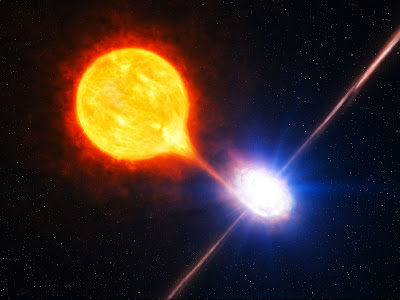Welcome to the Series of Dazzling thing in the Universe:- (Part -3)
Before making their final death plunge into the Black Hole.
In the disc, debris spins at unfathomable speeds, pulled around by a Black Hole billions of times more massive than our Sun. Friction in the accretion disc generates heat on a level difficult to fully appreciate. Just as hot things glow, the disc does too.
So, brightly it has its own name- A Quasar.
 |
| Quasars |
Quasars shine thousands of times more brightly than even the brightest stars.
Not just stars, it's scarier than that Quasar shine thousands of times more brightly than galaxies containing billions of stars.
The first identified Quasar, 3C273, has an absolute magnitude of -26.7,
 |
| 3C 273 Qusar |
making of it 4 trillion times brighter than our Sun about 100 times more luminous than the amount of light produced by the entire Milky Way.
If you put 3C273 33 light years away from us it would shine as brightly as our Sun a mere 8 light minutes away. Blocking the brightness of a Quasar with the corona graph reveals that the Quasars exist in the centres of galaxies that are larger than them in area, but are nonetheless drowned out by thin light.
Such Galactic centres are called Active Galactic Nuclei.
The bulk of their energy spewing forth in the form of a powerful radiation jet, the length of which puts even our Solar System to shame.
The visible part of the jet in this photograph, for instance, is so long it could stretch from the Sun to Pluto and back, 1 and a half million times.
Now, specifically, if a large portion of this ejection energy heads towards Earth, it's responsible for what we call a Quasar, but if Earth is right and the Active Galactic Nucleus sights, it's got a scarier name; Blazar.
 |
| Blazar |
It's Blazar that clocked in the greatest brightness ever observed.
At historically high levels of activity, it registered in absolute magnitude of -31.4.
To put this brightness of Quasars in yet another perspective, take a look at the one hundred thousandth picture snapped by the Hubble Telescope.
No comments:
Post a Comment
Let me know guys what you think about this.